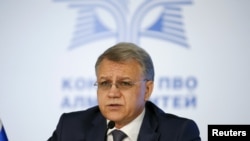The Russian maker of the Buk surface-to-air missile system says it has concluded that the Malaysian Airlines jet that crashed in eastern Ukraine last summer was hit by a version of the missile that is used by Ukraine but not by Russia.
The statement from state-controlled arms maker Almaz-Antei came two days after a British-based independent investigative group said it had determined that Russia’s Defense Ministry released doctored, misdated photographs to support Moscow's claim that a Ukrainian fighter jet shot down the plane.
All 298 people aboard Malaysian Airlines flight MH17 were killed when the passenger jet was shot down on July 17 while en route from Amsterdam to Kuala Lumpur, the deadliest single incident in a conflict between Russian-backed separatists and Ukrainian forces that has killed more than 6,400 people.
The findings released on June 2 by an adviser to the director of Almaz-Antei were the latest step by Moscow to counter accusations and evidence suggesting the jet was shot down by rebels with a Buk missile fired from territory under their control, as U.S. and German intelligence sources have said.
The adviser, Mikhail Malyshevsky, told a news conference in Moscow that the "initial phase" of the company's research showed that MH17 was shot down by an older version of the Buk that Russia has not produced for six years. He said that Ukraine's arsenal does include this version.
Malyshevsky said the analysis was based on photographs of the wreckage available to the public.
A report released on May 31 by British citizen journalist Eliot Higgins and his website, Bellingcat, concluded that satellite photographs released by the Kremlin days after the crash "were digitally modified using Adobe Photoshop CS5 software."
The report consisted of digital forensic analysis of those photos.
An independent team of Dutch investigators that has visited the crash site is to present its findings in October.









